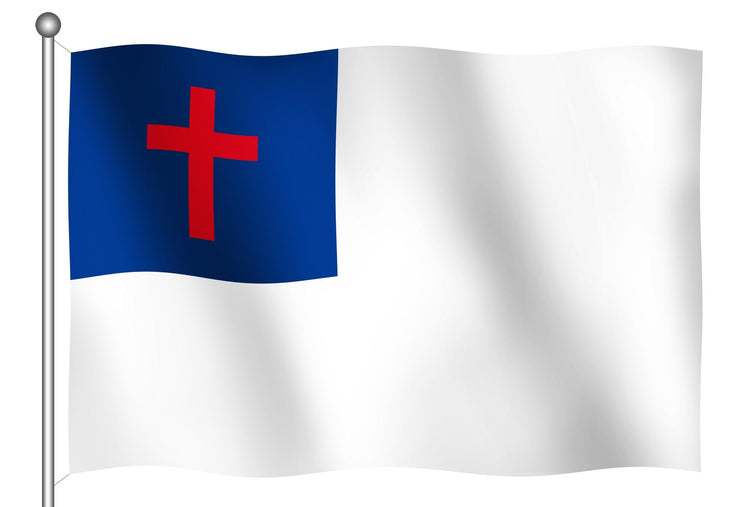Flags. Sea navigators and military around the world found good practice to utilize them. Sports teams have them showing off their colors. It is custom and necessary for countries to express themselves with their flags. You’ll see red flags on a windy beach where the waves are crashing. You might even see a yellow one by a railway, indicating to proceed with care. Most of them are rectangular; others may be square or pennon shaped.
A flag is often placed on a mountain to symbolize victory. You may see a white one when you abandon, quit, or cede a territory. They are used for decoration, communication, warning, symbolism, and proving your belonging to a band, tribe, or country. Flags are everywhere, and they represent some sense of identity. That’s why pledges to them are created.
We have a pledge to our American flag. Countries from the British Commonwealth pledge allegiance to the Queen, the flag, and the Constitution. Then some Christians had the idea to craft a Christian flag and its corresponding pledge.
Since it is not common knowledge, here are 10 facts about the Christian flag.
10 Facts About the Christian Flag
1. Its Genesis Is an Unplanned Speech
Most speeches are planned and prepared, then executed in front of an expecting audience. This was not so for the pledge to the Christian Flag.
Charles C. Overton, who was a Sunday School superintendent in Brooklyn, New York, was going to be an attentive listener to the projected speech to be given that day of September 26, 1897. But his day was going to take an unexpected turn: the communicator didn’t show up!
Being on the organizing team, Overton had to take the stage as the replacement. He was unprepared and his speech was unrehearsed yet, it can be assumed creativity was heightened by necessity. He saw an American flag near the podium, which prompted his discourse on the symbolism and utility of flags. The inception of the idea was now existent.
2. It Took 10 Years to Produce the First Christian Flag
Overton thought about the idea of the Christian flag and pledge for over ten years. It is unknown what happened in the period between the speech, the idea of having a Christian flag, and its actual conception.
What is known, however, is the teaming up of Overton and Ralph Diffendorfer, secretary to the Methodist Young People's Missionary Movement, to finally create, craft, and promote the flag in 1907.
With this endeavor beginning, a Methodist pastor, Lynn Harold Hough, decided to write the first draft of the pledge after hearing Diffendorfer.
3. The Christian Flag Celebrated Its Century of Existence in 1997
Though the pledge is not 100 years old, most people consider its birthday as the day of Overton’s address back in 1897.
4. There Are Actually Two Versions of the Pledge, Maybe More!
Hough’s first draft of the pledge was accepted by many, but not all. He was known as being liberal, thus his pledge was considered to be as well. Here’s what he wrote:
“I pledge allegiance to the Christian flag and to the Savior for whose kingdom it stands; one brotherhood, uniting all mankind in service and in love.”
More conservative Christians and Evangelicals desired something that actually referred closely to their Christian values and the flag itself. Though it isn’t clear who scripted the modified version, it is widely used in schools, VBS, and churches around the U.S. and the world.
“I pledge allegiance to the Christian flag, and to the Savior for whose Kingdom it stands; one Savior, crucified, risen, and coming again with life and liberty to all who believe.”
Here’s yet another iteration of it that the National Royal Rangers use, for example. (READ IT HERE)
“I pledge allegiance to the Christian Flag, and to the Savior for whose Kingdom it stands; one brotherhood uniting all [true] Christians, in service, and in love.”
Some change the wording of “I pledge allegiance to” by stating “I affirm my loyalty to.”In short, there is no single, definitive wording of the pledge itself.
5. It Is Customary for Many Christian Schools to Recite the Pledge to the Christian Flag on a Regular Basis
Many religious schools begin their day or week affirming the pledge to the American and Christian Flags. They often recite it during chapel times as well. Many even add the Bible pledge that goes like this:
“I pledge allegiance to the Bible, God’s Holy Word, I will make it a lamp unto my feet and a light unto my path and will hide its words in my heart that I might not sin against God. Amen.”
6. The Symbolism of the Christian Flag Matches Those of the U.S. Flag and Christian Beliefs
As with most flags, the Christian flag one is rectangular with three colors: white, blue, and red.
The white represents the purity, innocence, and peace of Christianity. The blue square in the top corner is the emblem of the Christian home, Heaven. Blue is also understood to characterize trust and faith, and for some, the baptism waters. The universally known Christian emblem, the Cross, is red, symbolizing the blood of Christ.
7. The Christian Flag Is Free of Patent
Many flags have a patent that dictates the manufacturing process. Diffendorfer, in his essay on “Missionary Education in Home and School,” wrote,
“The Christian flag is not patented and is free from commercialism. Anyone may manufacture it, and it may be used on all proper occasions. Christian flags may be displayed at conventions, conferences, church demonstrations, and parades, and with the American flag may be used for general decorative purposes. For boys' and girls' societies and clubs and for the church school, especially on program occasions, the two flags may be presented and saluted.”
8. It Was Used to Show Solidarity During the War
Many German Lutheran churches had the Christian flag flown as a sign of camaraderie with the U.S. during the Second World War.
9. The Christian Flag's Usage Spread in the World Through Missionaries
It is known that when Baptist missionaries began their ministries abroad, the Christian flag traveled with them. This is how the emblem got its worldwide recognition (Missions: American Baptist International Magazine, Volume 8. American Baptist Convention. p. 497.)
10. The Pledge Also Has a Matching Song
A Christian flag and a pledge wouldn’t be complete without a hymn attached to it. One of the most famed Christian hymnists, Fanny Crosby, wrote an anthem on another star of hymnal composers, Raymond Huntington Woodman’s music. She is known as the author of the classic hymn “Blessed Assurance.”
Frequently Asked Questions
1. What is the Christian Flag Pledge and who created the Christian Flag Pledge? Why?
The Christian Flag Pledge is a verbal expression of allegiance to Christ and His Kingdom, symbolized by the Christian flag. It was inspired by an unplanned speech by Charles C. Overton in 1897 and later developed with Ralph Diffendorfer. The pledge was created to instill Christian values and unity through a symbol that transcends denominations and nations.
2. What does each color on the Christian flag represent?
White symbolizes purity, peace, and the holiness of Christ. Blue stands for loyalty, faith, and heaven — the eternal home of believers. Red represents the blood of Jesus, shed for salvation, and the sacrifice at the heart of Christian faith.
3. Why do some Christian schools and ministries recite the Christian Flag Pledge?
The pledge is often part of chapel, morning assemblies, and VBS to center hearts on Jesus. It helps reinforce children's spiritual identity and commitment to Christian values. It also serves as a spiritual counterpart to national pledges, affirming allegiance to Christ above all.
4. How can children’s ministry pastors introduce the Christian Flag Pledge?
Teach the meaning behind each part of the pledge using age-appropriate language and visual aids, such as a real flag or coloring sheet. Incorporate the flag and pledge into themed lessons, such as those on loyalty, God's Kingdom, or following Jesus, to give it deeper context.
You can also create a pledge moment during weekly gatherings, similar to how schools use the Pledge of Allegiance.
Related Resources
Want to Remember This Page to Use Later?
Save this article on Pinterest! Just pin one of the photos below.









